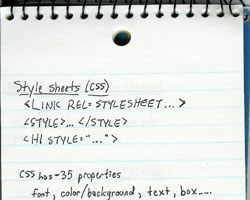Checks and Balances
Published 22 years, 2 months pastToday I received my first Complex Spiral paycheck. Yay! I’ve done several paying jobs by now, and more are underway, but this is the first check to actually show up for deposit. Let that be a lesson to those of you who might be thinking about striking out on your own: if you can’t cover all of the expenses you’ll incur between leaving your old job and the point two months after you finish your first project at the new job, you can’t afford it.
Yesterday, the mail brought to me a package from New Zealand. It contained a copy of the Digital Life episode on Web standards. That was especially fascinating since this morning an article on standards support (and the limits thereof in Internet Exporer) was published on c|net quoting me, Zeldman, and others. With Explorer’s development at an apparent end, it’s becoming a heavier and heavier millstone around the necks of designers. Let’s assume that there are no advances in Microsoft’s Web standards support between now and Longhorn. That’s close to three more years of the millstone getting heavier. By then, we’ll all have serious back problems.
(Yes, I can count: Microsoft’s Longhorn launch date of 2005 says to me it’ll actually launch in 2006. I’m just drawing a historical inference here.)
Of course, the whole Eolas situation probably doesn’t have the Microsoft folks in a benevolent frame of mind regarding standards. If they just abandoned the public Web and moved everything into a closed, proprietary sandbox of some kind, they might be able to avoid these sorts of problems altogether. That’s exactly what I expect them to do in Longhorn, and the expectation worries me. If the whole world moves into the sandbox—and let’s face it, in an e-commerce sense, IE/Win is the whole world—what reason would there be to pay any more attention to the Web?
We might say hey, fine, let’s get Microsoft and its partners the hell off the Web so we can go back to developing it the right way; let’s take back the neighborhood. That would make about as much sense as rooting for Flash to be the technology used on every Web site in existence. When one company owns the medium, everyone else loses. Thus far, the Web has been a community asset, with no one company calling the shots. How can we make sure that situation continues past the next few years?
